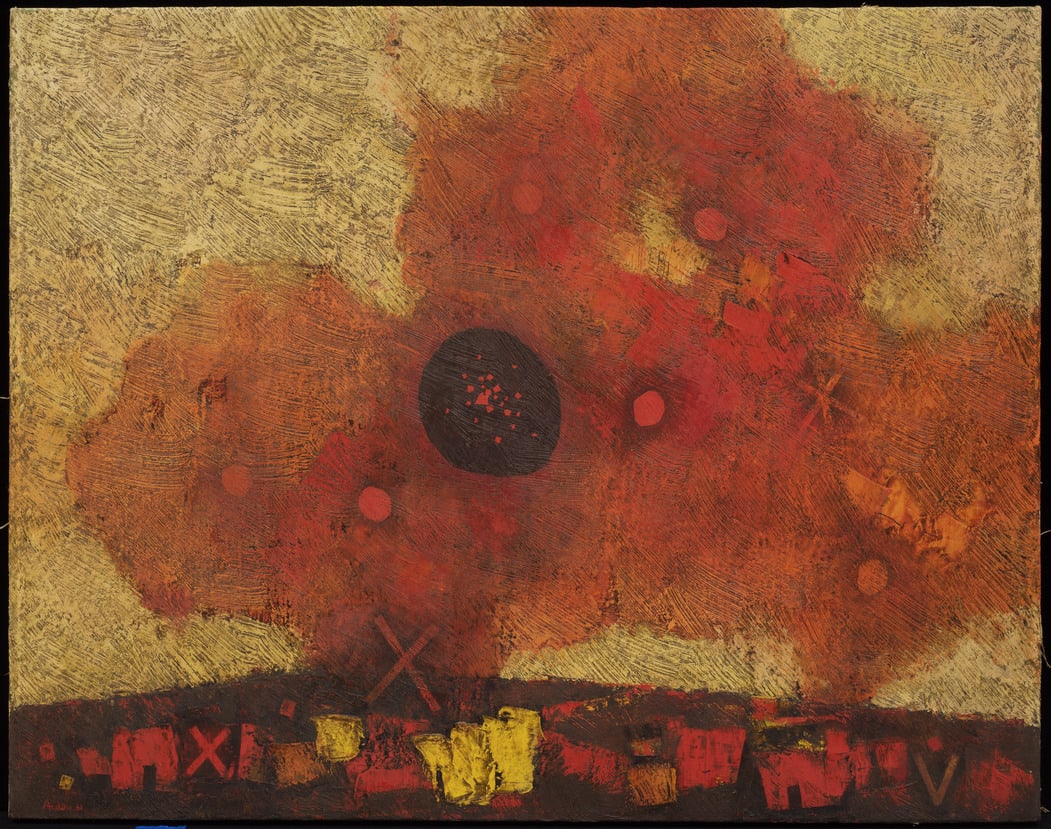
- Artist/Maker:
- Mordecai Ardon
- Bio:
- Israeli, b. Poland, 1896-1992
- Title:
- Landscape with Black Sun
- Date:
- 1961
- Medium:
- Oil on canvas
- Dimensions:
- 31 × 39 3/8 in. (78.7 × 100 cm)
- Credit Line:
- Purchase: Beren Foundation Fund
- Accession Number:
- 1998-59
Not On View
Most of the German Jewish artists who emigrated to Eretz Yisrael in the early 1930s settled in Jerusalem. A number of them became involved with the Bezalel School of Arts and Crafts, which was founded there in 1906. It was forced to close in 1929 as a result of financial and organizational problems, as well as harsh criticism of its rejection of modernism. When the school was reopened in 1935, its teachers were mostly of German Jewish origin. Mordecai Ardon was an important member of this artistic group, along with Jakob Steinhardt, Anna Ticho, and Leopold Krakauer. Regardless of their stylistic differences, these German artists had a great deal in common, and their culture and point of view were completely different from those of the Jewish expressionists in Paris. They were opposed to aestheticism for its own sake and believed that artists had a moral mission and that their work should have social meaning.
Born Mordecai Eliezer Bronstein in Tuchow, Poland, Ardon moved to Germany in 1919. His studies at the Bauhaus in Weimar from 1921 until its closing in 1924 brought him into close contact with Paul Klee, Wassily Kandinsky, and Lionel Feininger. From 1930 to 1933, he taught painting at Johannes Itten's school in Berlin. When compelled to flee Germany in 1933, he decided to immigrate to Palestine, although he was a Communist, not a Zionist. Once settled in Jerusalem, he joined the New Bezalel School of Arts and Crafts, becoming its director in 1940.
Until the 1940s, most of Ardon's paintings showed the panorama of the Judaean hills, with their mysterious light. In 1946, however, the artist turned to subjects related to the Holocaust. In the 1950s, Ardon's work developed in the direction that is reflected in Landscape with Black Sun.
This painting, a paradigmatic work by Ardon, attempts to address solemn tradition and historical events, couching their meaning in symbolic and ancient mystical signs and allegorical visions. While the artist does not refer explicitly to the Holocaust, the black sun and intense hues have been interpreted as a tragic vision of those events. Although the landscape symbolizes rather than narrates, the fiery red patterns that spread across the surface of the painting suggest a universe suffused with blood. Even the sun has turned black, suggesting a form of cosmic eclipse. This symbolic landscape hovers between nature and abstraction, creating a dynamic interaction between earth and sky, a space that brims with emotional energy. The lower portion of the painting reveals a black ground with yellow and red flat planes or color scattered in an irregular pattern. This layered painting, with rich textures, incisions, and broad brush strokes creates a mottled, tactile surface.
Using animated brush strokes for this and other landscapes as well as portraits, Ardon began in the early 1950s to condense full volumes into flat planes and compress figurative details into linear and geometric designs. Within a short time, his compositions developed into a poignant inner visual language divorced from external reality, formed by pictograms and abstract shapes that emerged in earthly, celestial, and apocalyptic backgrounds.
Born Mordecai Eliezer Bronstein in Tuchow, Poland, Ardon moved to Germany in 1919. His studies at the Bauhaus in Weimar from 1921 until its closing in 1924 brought him into close contact with Paul Klee, Wassily Kandinsky, and Lionel Feininger. From 1930 to 1933, he taught painting at Johannes Itten's school in Berlin. When compelled to flee Germany in 1933, he decided to immigrate to Palestine, although he was a Communist, not a Zionist. Once settled in Jerusalem, he joined the New Bezalel School of Arts and Crafts, becoming its director in 1940.
Until the 1940s, most of Ardon's paintings showed the panorama of the Judaean hills, with their mysterious light. In 1946, however, the artist turned to subjects related to the Holocaust. In the 1950s, Ardon's work developed in the direction that is reflected in Landscape with Black Sun.
This painting, a paradigmatic work by Ardon, attempts to address solemn tradition and historical events, couching their meaning in symbolic and ancient mystical signs and allegorical visions. While the artist does not refer explicitly to the Holocaust, the black sun and intense hues have been interpreted as a tragic vision of those events. Although the landscape symbolizes rather than narrates, the fiery red patterns that spread across the surface of the painting suggest a universe suffused with blood. Even the sun has turned black, suggesting a form of cosmic eclipse. This symbolic landscape hovers between nature and abstraction, creating a dynamic interaction between earth and sky, a space that brims with emotional energy. The lower portion of the painting reveals a black ground with yellow and red flat planes or color scattered in an irregular pattern. This layered painting, with rich textures, incisions, and broad brush strokes creates a mottled, tactile surface.
Using animated brush strokes for this and other landscapes as well as portraits, Ardon began in the early 1950s to condense full volumes into flat planes and compress figurative details into linear and geometric designs. Within a short time, his compositions developed into a poignant inner visual language divorced from external reality, formed by pictograms and abstract shapes that emerged in earthly, celestial, and apocalyptic backgrounds.
Information may change as a result of ongoing research.